-
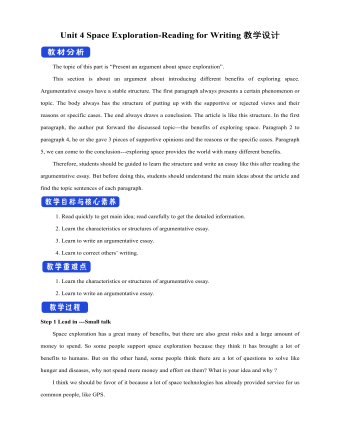
新人教版高中英语必修3Unit 4 Space Exploration-Reading for Writing教学设计二
⑦在我看来, 探索太空是值得的。As far as I am concerned, it is worthwhile to explore the space.Step 10 Writing---draftRecently, students in our class have had heated a discussion on whether space is worth exploring. Students hold different ideas about it.30% of us think space exploration is not worthwhile. They think space is too far away from us and our daily life and is a waste of money. And the money spent on space exploration can be used to solve the earth’s problems such as starvation and pollution.On the other hand,70% think space is worth exploring because we have benefited a lot from it,such as using satellites for communication and weather forecast. What’s more,with further space research,we may solve the population problem by moving to other planets one day. Also,space research will enable us to find new sources to solve the problem of energy shortages on the earth.As far as I am concerned, it is worthwhile to explore the space. Not only can it promote the development of society but also enrich our life. Step 11 Pair workExchange drafts with a partner. Use this checklist to help your partner revise his/her draft.1.Does the writer explain why he/she changed/wanted to change?2.Does the writer tell how the changes have improved or will improve his/her life?3.Is the text well-organised?4.Does the writer use words and expressions to show similarities and differences?5.Are there any grammar or spelling errors?6.Does the writer use correct punctuation?
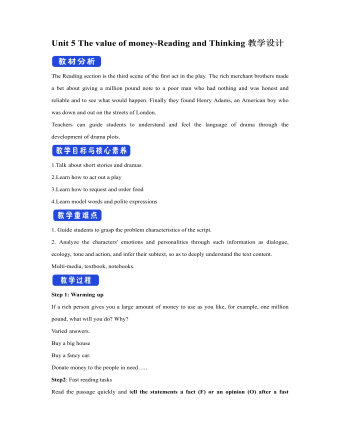
新人教版高中英语必修3Unit 5 The value of money-Reading and Thinking教学设计二
? Could you offer me some kind of work here?? I don’t want your charity, I just want an honest job.? Careless: I landed in Britain by accident.Step 7:Consolidation.? Find Henry? Roderick and Oliver were I .making a bet when they saw Henry, a poor young man. ? Know Henry? About a month ago, Henry was sailing and later he found himself carried out to sea by a strong wind. Fortunately, he 2.was spotted by a ship. And it was the ship that brought him to 3.England? Offer money to Henry ? Oliver and Roderick gave Henry a letter and told him that there was money in it. They 4.persuaded him to accept it, and made him 5.promise that it wouldn't be opened until 2 o'clock.Step 8:Language pointsa large amount of: a large quantity of; a great deal ofe.g. They bought a large amount of furniture before they moved their new house.make a bet: make an arrangement to risk money, etc. on an event of which the result is doubtful.e.g. We made a bet on the result of the match.permit sb to do something: allow somebody to do somethinge.g. My mother doesn’t permit me to ride in the street after it rained.by accident: as a result of chancee.g. I only found it by accident.stare at: look at somebody or something with the eyes wide open in a fixed gaze( in astonishment, wonder, fear, etc)to be honest: to tell you the truth; to be franke.g. To be honest, I don’t think we have a chance of winning.Step7 Homework:What do you think will happen to Henry? Will the bank-note help him or get him into trouble?

新人教版高中英语必修3Unit 5 The Value of Money-Reading for Writing教学设计二
2. 您能看到, 我头发太长了。You can see that my hair is much too long.3. 无论什么时候, 只要您想回来就回来。Please come back whenever you want.4. 您仅有很少的头发要理! You only have too little hair to cut !5. 为您服务是我的荣幸!It is my honour to serve you!Step 9 Writing(Henry is walking down the street when he sees a sign for a place that cuts hair. He decides to have it cut. )H=Henry B=BarberH: Good afternoon, I’d like to have my hair cut, if I may. (The barber looks at Henry’s hair and continues cutting another man’s hair. ) Er, I’d really like a haircut. As you can see it’s much too long. B: (in a rude manner) Yes, I can see that. Indeed, I can. H: Fine, well, I’ll have a seat then. (He sits in one of the barber’s chairs. The barber turns to look at Henry. )B: It’s quite expensive here, you know! Are you sure you can afford it?H: Yes. I think so. (After his hair is cut, the barber tells Henry how much he must pay. Henry shows the barber the bank note. )B: Why Mr. . . (looks shocked)H: Adams. Henry Adams. I’m sorry. I don’t have any change. B: Please don’t worry! (wearing a big smile) Nothing to worry about! Nothing at all! Please come back whenever you want, even if you only have too little hair to cut! It will be my honour to serve you!Step 10 Pair workExchange drafts with a partner. Use this checklist to help your partner revise his/her draft.1. Are all the elements of a play included and in good order ?2. Do the character use suitable language ?3. Are the stage directions clear and useful ?4. Is the plot clear and exciting enough ?

新人教版高中英语必修3Unit 1 Festivals and Celebrations-Reading for writing教学设计二
Step 3 Analyzing article structureActivity 31. Teachers raise questions to guide students to analyze the chapter structure of this diary and think about how to describe the festival experience. (1)What should be included in the opening/body/closing paragraph(s)?(2)How did the writer arrange his/her ideas?(3)What kind of interesting details did the writer describe?(4)How did the writer describe his/her feelings/emotions during the event?2. Students read and compare the three sentence patterns in activity 2. Try to rewrite the first paragraph of the diary with these three sentence patterns. After that, students exchange corrections with their partners. Such as:●This was my first time spending three days experiencing the Naadam Festival in China’s Inner Mongolia Autonomous Region and it was an enjoyable and exciting experience. ●I'll never forget my experience at the Naadam Festival because it was my first time to watch the exciting Mongolian games of horse racing, wrestling, and archery so closely. ●I'll always remember my first experience at the Naadam Festival in China’s Inner Mongolia Autonomous Region because it was so amazing to spend three days witnessing a grand Mongolian ceremony. Step 4 Accumulation of statementsActivity 41. Ask the students to read the diary again. Look for sentences that express feelings and emotions, especially those with the -ing form and the past participle. Such as:● …horse racing, wrestling, and archery, which are all so exciting to watch. ● some amazing performances● I was surprised to see…● I was a little worried about. . . ● feeling really tiredOther emotional statements:●I absolutely enjoyed the archery, too, but the horse races were my favourite part. ●I'm finally back home now, feeling really tired, but celebrating Naadam with my friend was totally worth it. ●He invited me back for the winter to stay in a traditional Mongolian tent and cat hot pot. I can’t wait!2. In addition to the use of the -ing form and the past participle, the teacher should guide the students in the appreciation of these statements, ask them to memorize them, and encourage them to use them reasonably in writing practice.
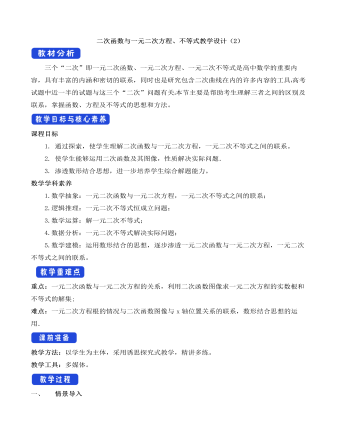
人教A版高中数学必修一二次函数与一元二次方程、不等式教学设计(2)
三个“二次”即一元二次函数、一元二次方程、一元二次不等式是高中数学的重要内容,具有丰富的内涵和密切的联系,同时也是研究包含二次曲线在内的许多内容的工具 高考试题中近一半的试题与这三个“二次”问题有关 本节主要是帮助考生理解三者之间的区别及联系,掌握函数、方程及不等式的思想和方法。课程目标1. 通过探索,使学生理解二次函数与一元二次方程,一元二次不等式之间的联系。2. 使学生能够运用二次函数及其图像,性质解决实际问题. 3. 渗透数形结合思想,进一步培养学生综合解题能力。数学学科素养1.数学抽象:一元二次函数与一元二次方程,一元二次不等式之间的联系;2.逻辑推理:一元二次不等式恒成立问题;3.数学运算:解一元二次不等式;4.数据分析:一元二次不等式解决实际问题;5.数学建模:运用数形结合的思想,逐步渗透一元二次函数与一元二次方程,一元二次不等式之间的联系。
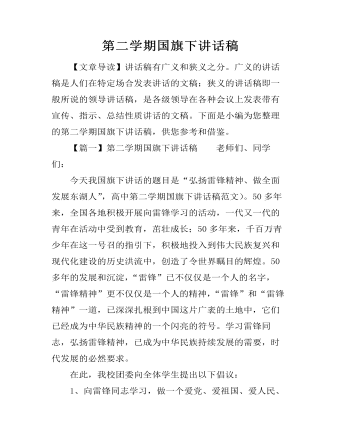
第二学期国旗下讲话稿
【文章导读】讲话稿有广义和狭义之分。广义的讲话稿是人们在特定场合发表讲话的文稿;狭义的讲话稿即一般所说的领导讲话稿,是各级领导在各种会议上发表带有宣传、指示、总结性质讲话的文稿。下面是小编为您整理的第二学期国旗下讲话稿,供您参考和借鉴。【篇一】第二学期国旗下讲话稿 老师们、同学们:今天我国旗下讲话的题目是“弘扬雷锋精神、做全面发展东湖人”,高中第二学期国旗下讲话稿范文)。50多年来,全国各地积极开展向雷锋学习的活动,一代又一代的青年在活动中受到教育,茁壮成长;50多年来,千百万青少年在这一号召的指引下,积极地投入到伟大民族复兴和现代化建设的历史洪流中,创造了令世界瞩目的辉煌。50多年的发展和沉淀,“雷锋”已不仅仅是一个人的名字,“雷锋精神”更不仅仅是一个人的精神,“雷锋”和“雷锋精神”一道,已深深扎根到中国这片广袤的土地中,它们已经成为中华民族精神的一个闪亮的符号。学习雷锋同志,弘扬雷锋精神,已成为中华民族持续发展的需要,时代发展的必然要求。
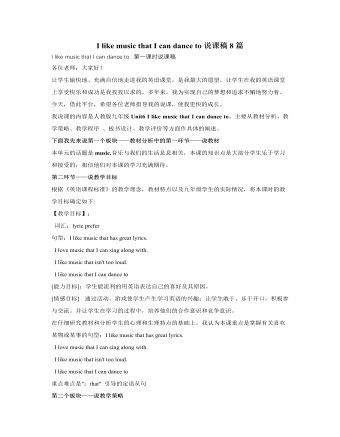
人教版新目标初中英语九年级上册I like music that I can dance to说课稿8篇
2、 难点结合功能句进行听力练习。确定目标的根据新课程标准规定,通过听、说、读、写的训练,使学生获得英语基础知识和初步运用英语进行交际的能力,激发学生的学习兴趣,为进一步的学习打基础。此外,根据我国国情及新课程标准的要求,现阶段英语教学的素质主要包括思想素质教育,潜在英语能力的培养,非智力因素的培养等几个方面。而我们班的学生本身英语基础不太好,部分学生已经对英语失去了信心,还有一部分学生觉得英语越来越难,渐渐力不从心了,不感兴趣了,上课注意力也不集中了。针对这种情况,备课时要增加趣味性,以此来提高学生对英语的学习兴趣。二、教法学法1、 教法:采取“任务型”教学法。教师根据本节课内容,安排合适的任务,让学生在完成任务的过程中达到本节课所拟定的目标。
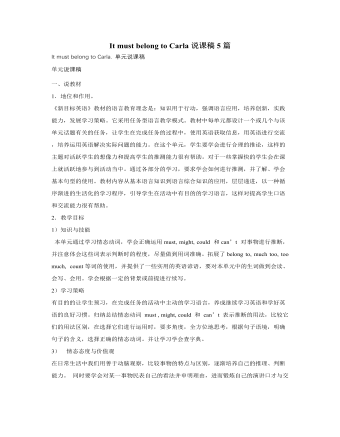
人教版新目标初中英语九年级上册It must belong to Carla说课稿5篇
二、教学目标: 1. 知识目标:要求学生掌握使用表示猜测的情态动词。2. 能力目标:让学生做课堂的主人,同时培养他们掌握一些行之有效的学习方法,优化学习效果。3. 情感目标:让学生爱上英语课堂活动,鼓励他们在课堂上进行合作交流。4.学习策略目标:设法使学生掌握使用英语进行交流,学习积极参与班级活动.三、教学分析:1. 说教法:1)任务型教学法:给学生三项任务, 让学生使用这些情态动词来完成这些任务。使他们在任务中学习英语。2)情景教学法:创造足够的交际环境刺激学生的视听能力,使他们能够更好的理解这些情态动词。以培养他们的听和会话能力。3)交易际教学法:学生可以通过俩俩对话或小组对话来掌握这些情态动词。2. 说学法:1)学生要善于把握机会,用英语进行沟通,大胆实践。
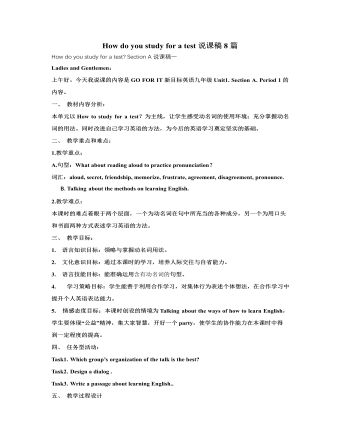
人教版新目标初中英语九年级上册How do you study for a test说课稿8篇
教学反思:这是学生升入初三的第一节课,学生学习热情很高,通过这一课时的学习,学生掌握了语言目标中所要求的知识重点、难点和语言技能,如by dong, practicing doing ,too……to,现在完成时态,动名词短语做主语及提建议的几种方式,但是有部分学生由于基础较差,还需要从培养学生学习兴趣入手,真正实现教育面向全体学生。在教学中采取的具体办法由:个别辅导,互助学习,留不同层次夫人作业,争取让每一位学生都吃饱而不掉队。How do you study for a test?Two periodsSection BGoals●To listen about learning English●To talk about learning English●To read about learning EnglishProceduresWarming up by reading to the recordingHello, everyone. To begin with, let’s listen and read to the recording of the text HOW DO YOU LEARN BEST? That is, read aloud to the tape, as fast as the tape goes, as clearly as the native reader reads. OK? Here we go!My cat speaks English. Sometimes my cat comes to me and tells me that she is hungry. Or that her leg hurts. How does my cat tell me these things? I don't speak pussy-cat language.1a Reading and checkingLearning English can be both easy and difficult. What things are easy for you? And what things are difficult for you? Now turn to page 5, read the list on the top and check √the statements that are true for you.1b Making a listYou have read and checked the statements true for you. Now think and make a list of other things difficult for you, too.
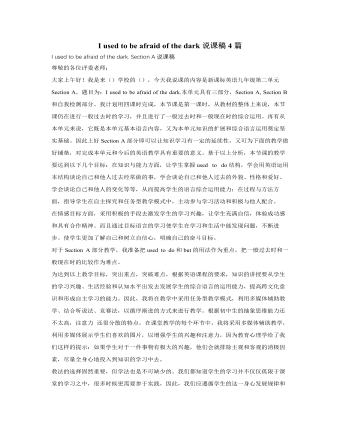
人教版新目标初中英语九年级上册I used to be afraid of the dark说课稿4篇
2、说说写写通过读写训练,进一步学会用 used to 结构来表达自己和同伴过去害怕,或现在仍旧害怕的事情,并且要把最后的结果书写下来,然后让他们将结果用英语告之其他同学,为学生创造展示才能的机会。这样能使全体同学都积极参与,集中精力认真听。既巩固了本节课的目标语言,又为下一个环节3b的对话打下基础。活动结问题比较容易,英语基础较差的学生也能够独立完成,因此,在检查答案是尽量让这部分学生回答,使他们体验到成功后的喜悦,提高他们学习英语的兴趣。 3.对话练习:让学生两人一组,模仿3a中的对话,根据提供的信息与提示词进行对话练习,目的在于对新学的目标语言进行口头练习与设定情景中的运用。为学生创造展示才能的机会。推荐两至三组的同学到教室前面,就所编的对话进行角色表演。
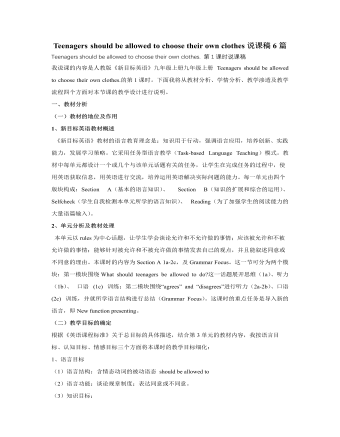
人教版新目标初中英语九年级上册Teenagers should be allowed to choose their own clothes说课稿6篇
二、教材分析本课时主要是以听和说的方式来谈论一些家庭和学校的“规矩和制度”,知道那些时可以做的,那些是不可以做的,让学生先从口头上了解这些规矩和制度,为后面的学习做好准备。三、教学的目的和要求1. 掌握短语be strict with sb.的用法,并介绍be strict in sth.的用法;2. 学生能够根据所学的知识,了解用什么方式/句型来制定规章制度。3. 多听,提高学生的习愿望,敦促学生开口说英语,用本课所学的知识来表达自己的意见。四、教学重点和难点1. 如何正确使用be allowed to do…这一句型(在不同时态中的被动语态运用)。2. 如何获得听力技巧及口语技能的提高。五、教学过程T—teacher S—studentS s—students Bb—blackboardStep 1 Warming up Check their homework first, and see if the Ss can make sentences by using the rules in 4, Section A. If possible, try to give some help.
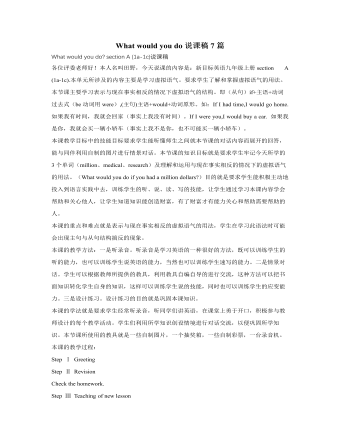
人教版新目标初中英语九年级上册What would you do说课稿7篇
Get students to complete the activity in groups of four. As the groups work together, move around the room to make sure students discuss the topic in English and know how to fill in the chart.Check the answers by asking different pairs of students to say their conversations to the class.Answers will vary.Optional activityAsk, What would you do if there were no classes tomorrow? Ask students to write as many answers as they can. Then get students to work in pairs. One ask the other the question and see how many new answers the other is able to think of.Step Ⅴ SummarySay, In this class, we've done a lot of reading, speaking and writing practice using the target language.Step Ⅵ Homework(1) Review the target language by reading the conversations in Activity 3a.(2) Finish off the exercises on pages 11~12 of the workbook.Step Ⅶ Blackboard DesignWhat would you do?Section AThe Third PeriodTarget language:A: I can't sleep the night before an exam. Then I'm too tired to do well. What should I do?B: If I were you, I'd take a long walk before going to bed. That should help you relax.A: I really want a dog, but my parents won't let me have one.B: Well, dogs can be a lot of trouble. Maybe you should get a small pet, like a goldfish.A: That's a good idea.
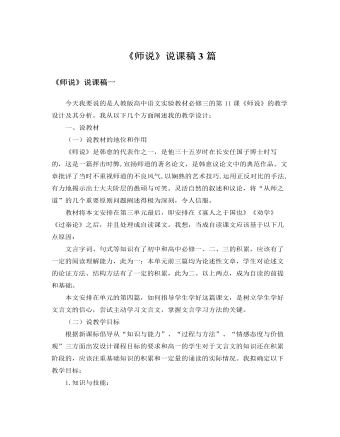
人教版高中语文必修3《师说》说课稿3篇
一、设计理念教学设计坚持少讲多学、以学为主的教学理念,重视学培养生的学习兴趣,要充分调动学生学习的积极性和主动性,充分发挥学生的主体性。教师要以组织者、引导者、合作者的角色参与到教学活动中去。力图通过导学案努力培养学生的自学习惯和自学能力。二、教材分析与处理1、教材的地位与作用:必修三第三单元所选的文言文都是古代的议论性散文。本课是“唐宋八大家”之首、中唐古文运动的倡导者韩愈的力作,是唐宋散文中的名篇,具有很强的代表性。通过这篇自读课的学习,能使学生了解唐宋散文的风貌,更能使学生进一步积累文言文基础知识,提高学生的文言文阅读欣赏能力,从而提升学生的文言文自读能力。2、教学目标:《高中语文课程标准》要求高中学生能阅读浅易文言文,能借助注释和工具书,理解词句含义,读懂文章内容;了解并梳理常见的文言实词、文言虚词、文言句式的意义或用法,注重在阅读实践中举一反三;对文章有一定的分析欣赏能力。高一的学生对于文言文的知识还在积累阶段,应该注重基础知识的积累和一定量的诵读。对此,我将教学目标确定为:
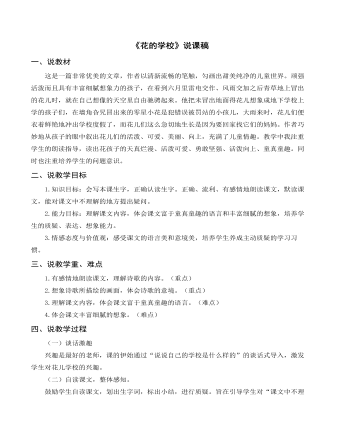
部编人教版三年级上册《花的学校》说课稿
一、说教材这是一篇非常优美的文章,作者以清新流畅的笔触,勾画出甜美纯净的儿童世界。顽强活泼而且具有丰富细腻想象力的孩子,在看到六月里雷电交作、风雨交加之后青草地上冒出的花儿时,就在自己想像的天空里自由驰骋起来。他把未冒出地面得花儿想象成地下学校上学的孩子们,在墙角旮旯冒出来的零星小花是犯错误被罚站的小孩儿,大雨来时,花儿们便衣着鲜艳地冲出学校度假了,而花儿们这么急切地生长是因为要回家找它们的妈妈。作者巧妙地从孩子的眼中叙出花儿们的活泼、可爱、美丽、向上,充满了儿童情趣。教学中我注重学生的朗读指导,读出花孩子的天真烂漫、活泼可爱、勇敢坚强、活泼向上、童真童趣。同时也注重培养学生的问题意识。二、说教学目标1.知识目标:会写本课生字,正确认读生字。正确、流利、有感情地朗读课文,默读课文,能对课文中不理解的地方提出疑问。 2.能力目标:理解课文内容,体会课文富于童真童趣的语言和丰富细腻的想象,培养学生的质疑、表达、想象能力。 3.情感态度与价值观:感受课文的语言美和意境美,培养学生养成主动质疑的学习习惯。
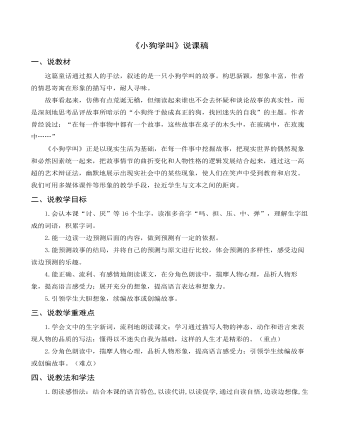
《小狗学叫》说课稿
你见过小狗学叫吗?作者贾尼?罗大里编写新时代出版社出版一本书籍的题目就是——《小狗学叫》,经过改编后作文课文被编排进了三年级上册语文课本。也就是我们今天要学习的课文。
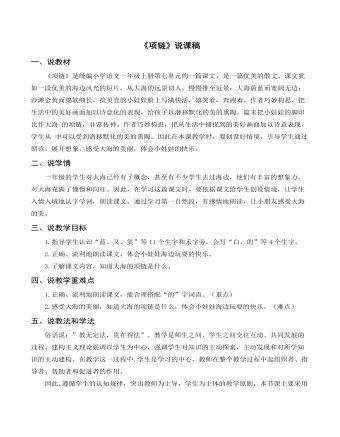
部编人教版一年级上册《项链》说课稿
四、说教学重难点1.正确、流利地朗读课文,能合理搭配“的”字词语。(重点)?2.感受大海的美丽,知道大海的项链是什么,体会小娃娃海边玩耍的快乐。(难点)五、说教法和学法俗话说:”教无定法,贵在得法”。教学是师生之间、学生之间交往互动、共同发展的过程。建构主义理论强调以学生为中心,强调学生对知识的主动探索、主动发现和对所学知识的主动建构。在教学这一过程中,学生是学习的中心,教师在整个教学过程中起组织者、指导者、帮助者和促进者的作用。? 因此,遵循学生的认知规律,突出教师为主导,学生为主体的教学原则,本节课主要采用学案导学、闯关游戏、小组竞赛的方式进行学习。教师主要为学生创设问题情境,引导学生在对话、讨论、交流中觅取新知,启发、点拨学生通过分析人物的心理描把握人物形象、领悟小说主旨。为了提高课堂学习效果,主要利用多媒体课件和学案来进行教学。
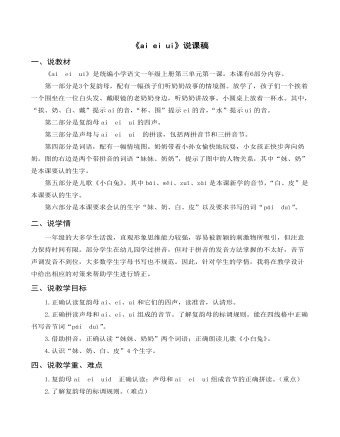
部编人教版一年级上册《ai ei ui》说课稿
一、说教材《ai?ei?ui》是统编小学语文一年级上册第三单元第一课。本课有6部分内容。第一部分是3个复韵母,配有一幅孩子们听奶奶故事的情境图。放学了,孩子们一个挨着一个围坐在一位白头发、戴眼镜的老奶奶身边,听奶奶讲故事。小圆桌上放着一杯水。其中,“挨、奶、白、戴”提示ai的音,“杯、围”提示ei的音,“水”提示ui的音。第二部分是复韵母ai?ei?ui的四声。第三部分是声母与ai?ei?ui?的拼读,包括两拼音节和三拼音节。第四部分是词语,配有一幅情境图。奶奶带着小孙女愉快地玩耍,小女孩正快步奔向奶奶。图的右边是两个带拼音的词语“妹妹、奶奶”,提示了图中的人物关系,其中“妹、奶”是本课要认的生字。第五部分是儿歌《小白兔》。其中bái、wěi、zuǐ、zài是本课新学的音节,“白、皮”是本课要认的生字。第六部分是本课要求会认的生字“妹、奶、白、皮”以及要求书写的词“pái?duì”。

部编人教版一年级上册《g k h》说课稿
2.识记形。(1)观察字形。除了引导学生从情境图中花环、水草和蝌蚪的组合、椅子的侧面等帮助记忆ɡ、k、h的形体外,还要引导学生充分发挥想象来记忆,教师在课前也可以收集一些图片帮助学生记忆。(2)书写字母。声母ɡ、k、h书写指导时,要注意两个新的笔画名称,“”叫竖左弯,“”叫左斜右斜。教师可边示范边讲清字母书写的笔顺和在四线三格中的位置。ɡ两笔写成,占中格和下格。书写时要注意“”的竖要写得直。k两笔写成,占上格和中格。书写时注意“”是一笔完成。h两笔写成,占上格和中格。书写时要注意第一笔竖要占到上格,和n的字形区分开来。(二)拼读教学1.两拼音节。教师要引导学生运用前面所学的方法自己拼读两拼音节,先个体拼读,然后和同伴互相评议。对学生不易区分的ɡù、kǔ、hǔ,教师要加以重点指导。拼读练习时,要和学生熟悉的汉字、事物联系起来,也可以进行适度的拓展,增强趣味性。如:2.三拼音节。这是学生第一次接触三拼音节,拼读难度较大。教师要借助拼读示意图讲清拼读规则,然后联系学生熟悉的事物以及识字单元中已学的“火”字,帮助学生正确拼读,降低难度。
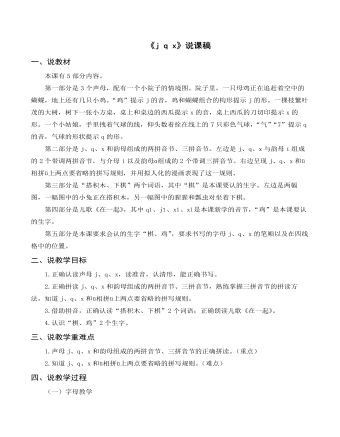
部编人教版一年级上册《j q x》说课稿
本课有5部分内容。第一部分是3个声母,配有一个小院子的情境图。院子里,一只母鸡正在追赶着空中的蝴蝶,地上还有几只小鸡。“鸡”提示j的音,鸡和蝴蝶组合的构形提示j的形。一棵枝繁叶茂的大树,树下一张小方桌,桌上和桌边的西瓜提示x的音,桌上西瓜的刀切印提示x的形。一个小姑娘,手里拽着气球的线,仰头数着拴在线上的7只彩色气球,“气”“7”提示q的音,气球的形状提示q的形。第二部分是j、q、x和韵母组成的两拼音节、三拼音节。左边是j、q、x与韵母i组成的2个带调两拼音节,与介母i以及韵母ɑ组成的2个带调三拼音节。右边呈现j、q、x和ü相拼ü上两点要省略的拼写规则,并用拟人化的漫画表现了这一规则。第三部分是“搭积木、下棋”两个词语,其中“棋”是本课要认的生字。左边是两幅图,一幅图中的小兔正在搭积木,另一幅图中的猩猩和瓢虫对坐着下棋。第四部分是儿歌《在一起》,其中qǐ、jī、xǐ、xì是本课新学的音节,“鸡”是本课要认的生字。第五部分是本课要求会认的生字“棋、鸡”,要求书写的字母j、q、x的笔顺以及在四线格中的位置。二、说教学目标1.正确认读声母j、q、x,读准音,认清形,能正确书写。2.正确拼读j、q、x和韵母组成的两拼音节、三拼音节,熟练掌握三拼音节的拼读方法,知道j、q、x和ü相拼ü上两点要省略的拼写规则。3.借助拼音,正确认读“搭积木、下棋”2个词语;正确朗读儿歌《在一起》。4.认识“棋、鸡”2个生字。
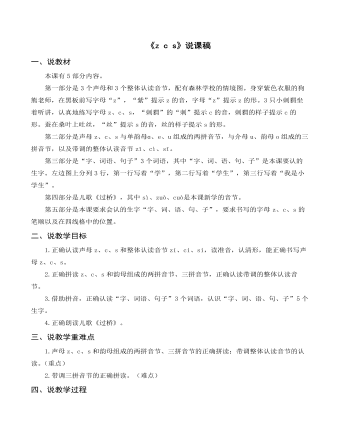
部编人教版一年级上册《z c s》说课稿
一、说教材本课有5部分内容。第一部分是3个声母和3个整体认读音节,配有森林学校的情境图。身穿紫色衣服的狗熊老师,在黑板前写字母“z”,“紫”提示z的音,字母“z”提示z的形。3只小刺猬坐着听讲,认真地练写字母z、c、s,“刺猬”的“刺”提示c的音,刺猬的样子提示c的形。蚕在桑叶上吐丝,“丝”提示s的音,丝的样子提示s的形。第二部分是声母z、c、s与单韵母ɑ、e、u组成的两拼音节,与介母u、韵母o组成的三拼音节,以及带调的整体认读音节zǐ、cì、sī。第三部分是“字、词语、句子”3个词语,其中“字、词、语、句、子”是本课要认的生字。左边图上分列3行,第一行写着“学”,第二行写着“学生”,第三行写着“我是小学生”。第四部分是儿歌《过桥》,其中sì、zuò、cuò是本课新学的音节。第五部分是本课要求会认的生字“字、词、语、句、子”,要求书写的字母z、c、s的笔顺以及在四线格中的位置。

